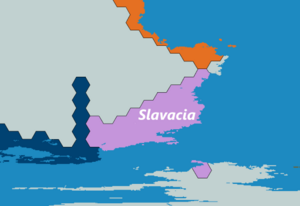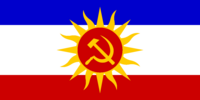Greater Slavacia
This article is incomplete because it is pending further input from participants, or it is a work-in-progress by one author. Please comment on this article's talk page to share your input, comments and questions. Note: To contribute to this article, you may need to seek help from the author(s) of this page. |
The Federation of Greater Slavacia "Велико-Славянская Федерацiя" | |
|---|---|
|
Flag | |
Motto: 'Свобода, равенство, миръ!' "Freedom, equality, peace!" | |
 Location of Greater Slavacia (pink) | |
| Capital | Novosergeevsk |
| Largest city | Petrograd |
| Official languages | Slavacian |
| Demonym(s) | Slavacian |
| Government | Federal semi-presidential constitutional republic |
• President | Maxim Borodin |
• Prime Minster | Igor Valenkov |
| Legislature | Federal Council |
| Area | |
• Total | 1,125,470 km2 (434,550 sq mi) |
| Population | |
• 2019 estimate | 302 246 450 |
• 2017 census | 301 768 143 |
• Density | 269/km2 (696.7/sq mi) |
| GDP (nominal) | 2019 estimate |
• Total | 2.12 trillion ₽ |
• Per capita | 6948.95 ₽ |
| Gini (2019) | 13.2a low |
| HDI (2019) | 0.92a very high |
| Currency | Slavacian Ruble (₽): 1 NS$ = .23 ₽ (SLR) |
| Date format | dd.mm.yyyy (13 days behind the International Calendar system) |
| Driving side | right |
| Calling code | +41 |
| Internet TLD | .sla |
| |
Greater Slavacia officially The Federation of Greater Slavacia is a federal semi-presidential constitutional republic comprised of a number of states and semi-autonomous republics. It is governed by a President, an elected legislature called the Federal Council, and a Judiciary - Ministry of Justice. It is located on the mainland and nearby off-shore islands on the southern coast of the continent of Archon in the Sovereign Charter.
History
Geography
Climate
Environment
Politics and Government
Military
Foreign Relations
Economy
During the decades of isolationism following the end of the Slavacian Civil War, the Slavacian economy has become almost completely self-sufficient, with trade making up less than 1% of the nations GDP. However, this has also let to a somewhat stagnant economy and most importantly a reputation of being a poor and somewhat underdeveloped nation. However, that is not the case. Due to nationalization of most natural resources (such as: coal, iron, oil and other various metals), as well as the nationalization of the means of production supplemented by punitive tax rates onto private enterprises (sometimes up to 65% for larger companies) the cost of living in Slavacia is very, very low. From birth every citizen is entitled to a free education, free medical care and upon reaching employment, a free apartment in the city of employment.
Energy
The energy production of Slavacia is handled by the Ministry of Energy and it's departments. The majority of the energy produced by the nation comes from nuclear power plants, although coal and hydroelectric power is also reasonably common. The next major step in the power generation industry is said to be fusion, with several experimental centers already producing power. However, their large operating and construction costs currently serve as the biggest deterrent from mass adoption of fusion power.
